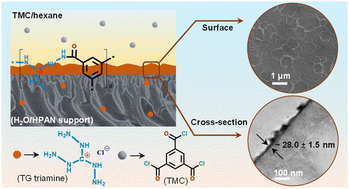Microporous poly(triaminoguanidinium-amide) nanofilms with sub-nm precision for ultra-low molecular weight cut-off in nanofiltration†
Abstract
High permeance nanofiltration membranes with an ultra-low molecular weight cut-off (MWCO) in the range of 150–200 g mol−1 and selective towards small solutes are essential for ionic and molecular separation. Despite the market dominance of thin film composite poly(piperazine-amide) nanofiltration membranes, the higher MWCO (>250 g mol−1) limits their widespread applications in molecular-level discrimination. Herein, we report the fabrication of new carbo-cationic microporous poly(triaminoguanidinium-amide) nanofilm composite membranes from an alkaline solution of triaminoguanidinium chloride (TG) and hexane solution of trimesoyl chloride (TMC) via interfacial polymerization. The microporous (mean pore size ∼1.1–1.3 nm) structure of the nanofilm with a thickness down to ∼30 nm allows convective transport of water with permeance as high as 19.0 ± 0.5 L m−2 h−1 bar−1 (at 4 bar), and tunable salt rejection of MgCl2 (21.5–85%), NaCl (41.6–85%) and Na2SO4 (98.7–99.7%) with a high ion selectivity of ∼140 between NaCl and Na2SO4. The membranes exhibit a low MWCO of 163–200 g mol−1 for neutral solutes, low rejection of glycerol (∼32.0%), high rejection of NaCl (∼85%), and excellent stability at low pH. Such ultra-low MWCO membranes would boost their applications in antibiotic removal, desalination, wastewater treatment, and many industrial separation problems concerning separating small neutral solutes.



 Please wait while we load your content...
Please wait while we load your content...